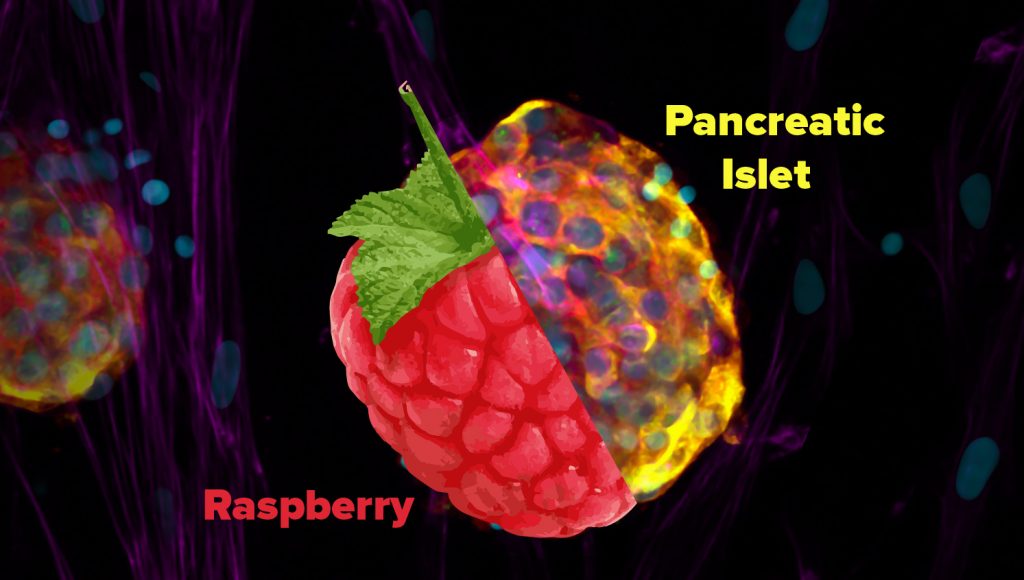By: Smit Patel, Ph.D. candidate in the Stabler Laboratory
Smit Patel, Ph.D. candidate within the Stabler laboratory has recently published his lead-author paper in the journal Science Advances titled, Organoid Microphysiological System Preserves Pancreatic Islet Function within 3D Matrix.
This work is supported by Human Islet Research Network (HIRN), National Institute of Diabetes and Digestive and Kidney Diseases (NIH | NIDDK), UF Biomedical Engineering, University of Miami Biomedical Engineering and lead by Cherie Stabler, Ph.D., professor and Integra LifeSciences Term Professor & Ashu Agarwal, Ph.D., associate professor.
Highlights:
- A Lab-on-a-Chip platform for organoids w/ wide capabilities: long-term culture | controlled & dynamic perifusion | in situ spatio-temporal imaging | serial cell assessment | ease of sample retrieval
- Continuous fluidic flow increased local oxygen supply to islets in hydrogels & reduced cellular hypoxia
- Flow increased cellular viability & reduced apoptosis & cell death
- Human islets in hydrogels were highly functional during the 10 day in situ culture in our chips, while islet function was rapidly lost under static conditions
- Glucolipotoxicity study showed a treatment window as small as 2.5 hours can elevate cell death
The practice of in vitro cell culture monolayers on static, two-dimensional (2D) glass or polystyrene surfaces has provided the foundation for numerous biomedical discoveries over the past century. The inability of these 2D cells and their culture systems to recapitulate critical human in vivo physiological responses, however, has been well documented. Three-dimensional (3D) and multicellular organoids, think of them like a miniaturized version of an organ, have the potential to accelerate the process of scientific discovery.
What are organoids? – A miniaturized version of an organ that imitates an aspect of the human interface. They are commonly developed from stem cells in a lab. The human body also produces organoids naturally, particularly within the pancreas. Think of organoids like a microscopic version of raspberries comprised of small spheres. These raspberry-like organoids in the pancreas are called the islets that manufacture insulin and maintain glucose homeostasis.

Photo: Raspberry | Islet (yellow = insulin & blue = cellular nuclei)
Problem: Culturing organoids traditionally leads to a precipitous loss of cell mass & function. This is at least due to oxygen deprivation, lack of nutrients exchange, and the loss of native 3D microarchitecture. Tools used to evaluate islet function make it hard to recover cells as they are trapped in a device or a slurry. As a result, the utility of islet organoids for pharmaceutical screenings, biological studies, and transplantation therapies is extremely limited.
Our Solution: Lab-on-a-chip platform

What is this technology? It is a replica of a specific organ interface on a microchip. This islet-on-a-chip device mimics the dynamic environment of the islet niche by providing a microfluidic flow to the cells that are also embedded in a 3D hydrogel. These devices permitted a continuous long-term culture, in situ spatio-temporal imaging, serial functional assessment, and ease of sample retrieval of multicellular organoids. Under continuous fluidic flow, these devices could provide increased local oxygen supply to organoids embedded in hydrogels. Fluid flow also increased the viability of primary islets and reduced the initiation of cell death pathways. Moreover, human islets in hydrogels were highly functional for at least 10 day of in situ culture in these devices, while islet function was rapidly lost under static conditions.
Altogether, this study is the first to demonstrate the assessment of the same set of islets over a long period of time. This study showed a sequential, functional assessment of the same pancreatic islets and simultaneous tracking of its viability and calcium signaling. The overall impact of this work is that the culture and multiparametric assessment of organoids within the Lab-on-a-Chip platform may provide valuable data for the development of emerging therapeutics and the study of diabetes.
